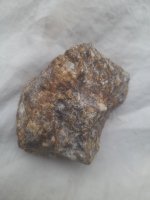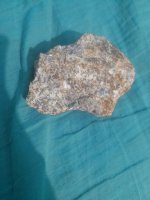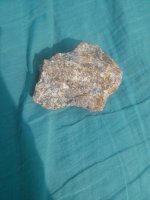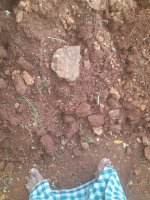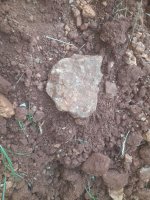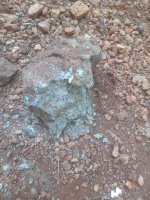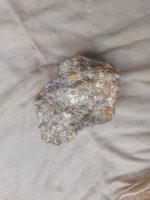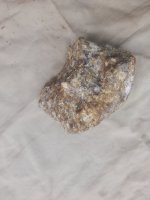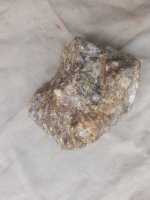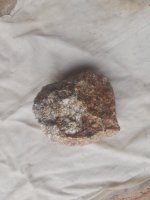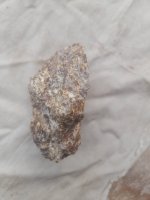What type of hematite ore is this?
Navigation
Install the app
How to install the app on iOS
Follow along with the video below to see how to install our site as a web app on your home screen.
Note: This feature may not be available in some browsers.
More options
You are using an out of date browser. It may not display this or other websites correctly.
You should upgrade or use an alternative browser.
You should upgrade or use an alternative browser.
Hematite ore
- Thread starter Fodegrass
- Start date
What type of hematite ore is this?

"...Hematite is one of the most abundant minerals on Earth's surface and in the shallow crust. It is an iron oxide with a chemical composition of Fe2O3. It is a common rock-forming mineral found in sedimentary, metamorphic, and igneous rocks at locations throughout the world..." SOURCE: Hematite - Properties, uses, and occurrence of the most important ore of iron.
Upvote
1
Bucket Lister
Bronze Member
- Dec 20, 2023
- 1,037
- 1,905
- Detector(s) used
- XP Dēus II
XP MI-6
XP WSA II-XL
- Primary Interest:
- Metal Detecting
I don't understand the question, and I'm not even sure that is hematite, though there may be some hematite in it.What type of hematite ore is this?
It can look quite different, but the vast majority of common hematite I've seen looks more like these:
Red Hematite
Grey Hematite
You can find much more here:
Hematite: The mineral hematite information and pictures
There is a list of "types" there, but these lists can differ between sites/sources.
Upvote
1
Red-Coat
Gold Member
Agree it doesn't look much like hematite to me either. You can confirm (or otherwise) with a streak test on the unglazed back of a ceramic tile. You need to blow away any dust and examine the colour of the streak itself. Hematite and hematite-rich rocks will streak from reddish brown through to blood-red.
Upvote
0
- Thread starter
- #6
The streak is cherry red.Agree it doesn't look much like hematite to me either. You can confirm (or otherwise) with a streak test on the unglazed back of a ceramic tile. You need to blow away any dust and examine the colour of the streak itself. Hematite and hematite-rich rocks will streak from reddish brown through to blood-red.
Upvote
1
- Thread starter
- #7
The streak is cherry red.Agree it doesn't look much like hematite to me either. You can confirm (or otherwise) with a streak test on the unglazed back of a ceramic tile. You need to blow away any dust and examine the colour of the streak itself. Hematite and hematite-rich rocks will streak from reddish brown through to blood-red.
Thanks for the infoI don't understand the question, and I'm not even sure that is hematite, though there may be some hematite in it.
It can look quite different, but the vast majority of common hematite I've seen looks more like these:
Red Hematite
View attachment 2159434
Grey Hematite
View attachment 2159435
You can find much more here:
Hematite: The mineral hematite information and pictures
www.minerals.net
There is a list of "types" there, but these lists can differ between sites/sources.
Upvote
0
- Thread starter
- #9
The streak is cherry red.Agree it doesn't look much like hematite to me either. You can confirm (or otherwise) with a streak test on the unglazed back of a ceramic tile. You need to blow away any dust and examine the colour of the streak itself. Hematite and hematite-rich rocks will streak from reddish brown through to blood-red.
Thanks for the infoI don't understand the question, and I'm not even sure that is hematite, though there may be some hematite in it.
It can look quite different, but the vast majority of common hematite I've seen looks more like these:
Red Hematite
View attachment 2159434
Grey Hematite
View attachment 2159435
You can find much more here:
Hematite: The mineral hematite information and pictures
www.minerals.net
There is a list of "types" there, but these lists can differ between sites/sources.
Weakly magnetic and hardness around 5.5Does a magnet attract, repel or non action?
What's the hardness?
Cinnabar, Cuprite....
Upvote
0
ConceptualizedNetherlandr
Bronze Member
Fun thing about fine grained iron. Treat the specimen with HCl ( soak days) then rinse and notice a rainbow of colors like an oil sheen. The various oxidation states and grain size variations act like prism reflectors.
Upvote
0
- Thread starter
- #17
Sorry currently I don't have hcl and I can't buy it now because of personal reasons. So do you think it is hematite?Fun thing about fine grained iron. Treat the specimen with HCl ( soak days) then rinse and notice a rainbow of colors like an oil sheen. The various oxidation states and grain size variations act like prism reflectors.
Upvote
0
ConceptualizedNetherlandr
Bronze Member
It does not look to be a pure sample of anything. I would need better photos or better yet to examine it.Sorry currently I don't have hcl and I can't buy it now because of personal reasons. So do you think it is hematite?
Upvote
2
Bucket Lister
Bronze Member
- Dec 20, 2023
- 1,037
- 1,905
- Detector(s) used
- XP Dēus II
XP MI-6
XP WSA II-XL
- Primary Interest:
- Metal Detecting
TMK, hematite is never white or clear-white (like quartz). I think what you've got are some metamorphic rocks with some iron content.
TBH, the two samples circled below look more like hematite than the samples you've been asking about, and I can't even be sure about them.

It's very difficult--nigh impossible--to definitively identify rocks/minerals by photo alone. This is why geologists/mineralogists use other tests
 en.wikipedia.org
to identify/confirm.
en.wikipedia.org
to identify/confirm.
Hematite is one of the most abundant minerals on the planet. Is there some particular reason you're pursuing it?
TBH, the two samples circled below look more like hematite than the samples you've been asking about, and I can't even be sure about them.
It's very difficult--nigh impossible--to definitively identify rocks/minerals by photo alone. This is why geologists/mineralogists use other tests
List of mineral tests - Wikipedia
Hematite is one of the most abundant minerals on the planet. Is there some particular reason you're pursuing it?
Upvote
0
Top Member Reactions
-
 3472
3472 -
 1993
1993 -
 1723
1723 -
 1444
1444 -
 1197
1197 -
 1178
1178 -
 916
916 -
 886
886 -
 822
822 -
 821
821 -
 650
650 -
 613
613 -
 475
475 -
 474
474 -
E
459
-
 449
449 -
 408
408 -
 389
389 -
 358
358 -
 334
334
Users who are viewing this thread
Total: 2 (members: 0, guests: 2)


